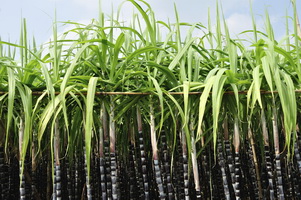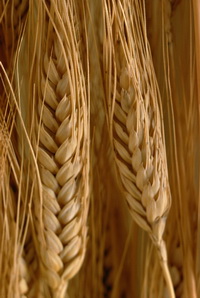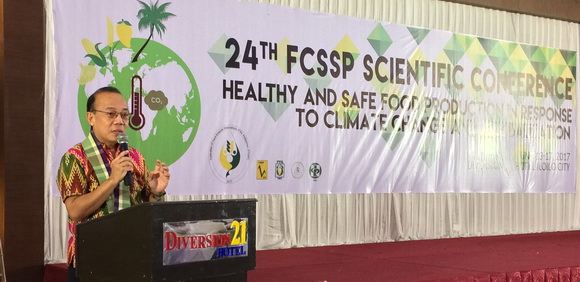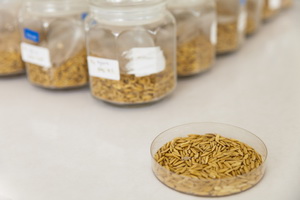CROP BIOTECH UPDATE
---------------------------------------------------------------------------
A weekly summary of world developments in agri-biotech for developing countries, produced by the Global Knowledge Center on Crop Biotechnology, International Service for the Acquisition of Agri-biotech Applications SEAsiaCenter (ISAAA)
---------------------------------------------------------------------------
June 14, 2017
In This Week’s Issue:
News
Americas
• Breakthrough Research Makes Synthetic Photosynthesis Possible
• Detailed New Maize Reference Genome Shows Its Deep Resources for Continued Adaptation
• Brazil Approves GM Sugarcane for Commercial Use
• Researchers Identify Gene Against Wheat Streak Mosaic Virus
Asia and the Pacific
• Study Shows Rice First Cultivated in China 10,000 Years Ago
• Filipino Crop Scientists Tackle Ways to Face Climate Change and Globalization
• South Korean Consumer Group Hosts ISAAA Brief 52 Seminar
Europe
• Scientists Discover that Symbiotic Fungi Get Carbon from Plants in the Form of Fatty Acids
• Apple Genome Sequence Published
Research
• Alcohol dehydrogenase 1 Confers Abiotic and Biotic Stress Resistance in Arabidopsis
• Non-target Arthropod Risk Assessment for Bt Rice in China
New Breeding Technologies
• Functional Characterization of OsSAPK2 Using CRISPR-Cas9
• CRISPR-Cas9-Mediated Deletion of a Target Gene in Indica Rice
Beyond Crop Biotech
• Researchers Identify a Carotenoid Biosynthetic Gene in Rhodosporidium toruloides
Document Reminders
• EFSA Releases Literature Review of Baseline Information on Assessment of RNAi-based GM Plants
----
NEWS
----
Americas
BREAKTHROUGH RESEARCH MAKES SYNTHETIC PHOTOSYNTHESIS POSSIBLE
Photosynthesis is one of nature's most important processes. Aside from producing oxygen, this natural process converts solar to chemical energy by transforming atmospheric carbon dioxide and water into sugar molecules to provide plants with needed food and energy to survive.
Scientists have tried to artificially replicate this energy conversion process to produce environmentally friendly and sustainable fuels such as hydrogen and methanol. Mimicking the process has been challenging to scientists as artificial photosynthesis requires the creation of a molecular system that absorbs light, transports and separates electrical charge, and catalyzes fuel-producing reactions. All are complicated processes that must operate synchronously to achieve high energy-conversion efficiency.
A team of researchers led by chemists from the U.S. Department of Energy's (DOE) Brookhaven National Laboratory and Virginia Tech has designed two photocatalysts that combine individual components for light absorption, charge separation, or catalysis into a single "supramolecule." Each supramolecule is made up of multiple light-harvesting ruthenium (Ru) metal ions connected to a single catalytic center of rhodium (Rh) metal ions. The researchers found that the supramolecule with six Ru centers and one Rh center was seven times more efficient than the other, cycling 300 times to produce hydrogen for 10 hours. The larger of the supramolecules was slightly electron-deficient, making it more receptive to electrons needed for synthetic photosynthesis.
For more details, read the article at Brookhaven National Laboratory.
DETAILED NEW MAIZE REFERENCE GENOME SHOWS ITS DEEP RESOURCES FOR CONTINUED ADAPTATION
Doreen Ware of Cold Spring Harbor Laboratory (CSHL) and the U.S. Department of Agriculture, led scientists from seven academic institutions and several genome technology companies in the project that produced a much more detailed reference genome for maize, or corn. According to Ware, the new genome for maize shows the plant's flexibility, which explains why maize has been successful since its adaptation thousands of years ago. It also provides insights on the plant's ability to thrive in new places as the planet's climate changes, and for increasing its productivity and environmental sustainability in the U.S. and abroad.
The maize genome is large, but its size is not responsible for its "phenotypic plasticity," the potential range in its ability to adapt. Ware explains that, in trying to determine the possibilities for a plant when adapting to new or changing conditions, the genes that are activated—or silenced—determines what the total set of genes enables a plant to do. The research group assembled a highly accurate and very detailed reference genome for an important maize line called B73, and compared it with genome maps for maize individuals from two other lines (W22 and Ki11), grown in different climates. The team arrived at an astonishing realization: maize individuals are much, much less alike at the level of the genome than people are. This difference among maize individuals reflects the changes in the sequence of the genes themselves, where and when they are expressed, and at what levels, explains Yinping Jiao, a postdoctoral researcher in the Ware lab and first author of the paper announcing the new genome.
For more details, read the article at CSHL News & Features.
BRAZIL APPROVES GM SUGARCANE FOR COMMERCIAL USE
 On June 8, 2017, Brazil's Comissão Técnica Nacional de Biossegurança (CTNBio, or National Biosafety Technical Commission) has approved the commercial use of the first genetically modified (GM) Bt sugarcane (Bt Sugarcane), CTC 20 BT, developed by the Brazilian company Centro de Tecnologia Canavieira (CTC).
On June 8, 2017, Brazil's Comissão Técnica Nacional de Biossegurança (CTNBio, or National Biosafety Technical Commission) has approved the commercial use of the first genetically modified (GM) Bt sugarcane (Bt Sugarcane), CTC 20 BT, developed by the Brazilian company Centro de Tecnologia Canavieira (CTC).
Bt Sugarcane, the first GM sugarcane approved for cultivation in the world, is resistant to damages caused by sugarcane borer (Diatraea saccharalis), the main pest of sugarcane in Brazil. According to agricultural experts in Brazil, damage caused by the sugarcane borer results in approximately R$5 billion per year. The Bt gene (Bacillus thuringiensis) in CTC 20 BT, has been used widely for over 20 years in biotechnology-derived crops such as soybean, maize, cotton, and brinjal/eggplant.
The scientific dossier which evaluated Bt Sugarcane was submitted to CTNBio in 2015 for health and environmental safety assessments using internationally-accepted standards. Processing studies proved that sugar and ethanol from the new variety are the same as those derived from conventional sugarcane. The studies also showed that both the Bt gene and protein in CTC 20 BT Sugarcane are completely eliminated from sugarcane derivatives during the manufacturing process. Environmental studies did not find any negative effects on soil composition, sugarcane biodegradability, or insect populations, with the exception of the target pests (mainly the borer). CTC will now work closely with producers, starting with the distribution of 20 Bt Sugarcane seedlings, followed by closely-monitored field planting.
For more details, read the article from the Brazilian Sugarcane Industry Association (UNICA).
RESEARCHERS IDENTIFY GENE AGAINST WHEAT STREAK MOSAIC VIRUS
 Researchers from Kansas State University have identified a gene that can resist wheat streak mosaic virus. The team identified Wsm3 gene, the third gene known to resist the virus, and the first that can do so at outdoor temperatures of 75 degrees Fahrenheit and higher.
Researchers from Kansas State University have identified a gene that can resist wheat streak mosaic virus. The team identified Wsm3 gene, the third gene known to resist the virus, and the first that can do so at outdoor temperatures of 75 degrees Fahrenheit and higher.
The first two genes known to provide resistance to the virus were Wsm1 (identified by Kansas State University about 25 years ago) and Wsm2 (discovered by researchers at Colorado State University), but these two provide protection in lower temperatures only. The researchers hope that the warm-weather friendly Wsm3, used in combination with Wsm1 or Wsm2, could become part of a breeding mix that can give farmers much-needed relief.
Wheat streak mosaic virus causes severe yield losses, and in extreme cases, the crop cannot be harvested.
For more information, read the article at K-State Research and Extension News.
Asia and the Pacific
STUDY SHOWS RICE FIRST CULTIVATED IN CHINA 10,000 YEARS AGO
Rice, one of the vital staple for many countries, was first domesticated in
China about 10,000 years ago. This is according to the study conducted by researchers at the Chinese Academy of Sciences (CAS) and published in the US
Proceedings of the National Academy of Sciences.
The researchers recovered rice remains from the Shangshan site in the Lower Yangtze in China. The remains were recognized as the earliest examples of rice cultivation. They developed a new process to isolate rice phytoliths from clays and carbonate, and dated the samples through radiocarbon dating. The results showed that the remains are approximately 9,400 years old. Furthermore, they found that approximately 36 percent of rice phytoliths at Shangshan had more than nine fish-scale decorations, less than the approximately 67 percent counted from modern domesticated rice, but larger than the approximately 17 percent found in modern wild rice.
This shows that rice was first domesticated in the same period when
wheat was first cultivated in the Near East and
maize in South America, which also occurred around 10,000 years ago.
Read more about the study from
CAS.
FILIPINO CROP SCIENTISTS TACKLE WAYS TO FACE CLIMATE CHANGE AND GLOBALIZATION
The Federation of Crop Science Societies gathered around 450 crop researchers from different regions of the Philippines for its 24th Scientific Conference in Diversion21 Hotel, Iloilo City on June 13-17, 2017. The conference aims to tackle crop research and its importance in facing climate change and globalization, focusing on its theme: Healthy and safe food production in response to climate change and globalization.
Dr. Vivencio Mamaril, OIC Director of the Bureau of Plant Industry and Director of the DA Biotechnology Program Implementation Unit, stressed that the Philippines is one of the top producers of biotech crops all over the world. He also discussed the Philippine experience in developing and implementing regulations on biotech crop during one of the plenary talks. Dr. Leocardio Sebastian of CGIAR Research Program on Climate Change, Agriculture, and Food Security discussed about the climate change preparedness of the Philippine agriculture industry. He encouraged the use of climate resilient crops to attain food security amid the effects of climate change.
Aside from the plenary talks, the latest crop researches in the Philippines will also be featured in oral and poster presentations. Outstanding researchers will also be honored and awarded during the conference.

For more information, send an e-mail to knowledge.center@isaaa.org.
SOUTH KOREAN CONSUMER GROUP HOSTS ISAAA BRIEF 52 SEMINAR
Highlights of the ISAAA Brief 52 Global Status of Commercialized Biotech/GM Crops for 2016 were presented by Dr. Paul S. Teng and Dr. Rhodora R. Aldemita to some 50 participants composed of representatives from the government, academia, industry, and media at the Korea Agro-Fisheries & Food Trade Corp., Seoul, South Korea on June 9, 2017.
Korean Research Institute of Bioscience and Biotechnology Scientist Emeritus Dr. Hang Ryol Liu, who is also the president of consumer group Future Food Resources Forum (FFRF), opined that in South Korea, vocal critics hinder adoption of biotech crops. "GMOs are being met with unconditional opposition without scientific basis, but the Korean public must appreciate the contributions of biotech crops in solving hunger by increasing productivity and enhancing the quality of the products," he said in his message.
Sejong University Emeritus Professor Dr. Kyu Hang Kyung moderated the event and provided short summaries of the presentations. He emphasized that through more interaction with biotech critics on the safety and nutritive potentials of biotech crops, negative perceptions by consumers will definitely be minimized. He also reiterated the fact that biotech crops and products have been in the Korean diet since 1996 and there has not been any recorded ill effects.

The event was co-organized by FFRF, Korean Biotechnology Information Center and CropLife Korea. For further details, contact knowledge.center@isaaa.org.
Europe
SCIENTISTS DISCOVER THAT SYMBIOTIC FUNGI GET CARBON FROM PLANTS IN THE FORM OF FATTY ACIDS
Arbuscular mycrorrhizal fungi, which attack plant roots and then aid the plant in nutrient absorption, get their carbon needs from their plant hosts in the form of long-chain fatty acids, a building block for essential lipids. This is according to the discovery of plant scientists from Rothamsted Research and John Innes Center, which was published in the journal Science. This important discovery debunks the long-standing literature that plant delivers carbon through carbohydrates to the symbiotic fungi, then the fungi manufacture their own fatty acids for survival.
The researchers initially isolated two important
genes involved in sustaining symbiosis. "We grappled with understanding why these genes were so important until we came up with the hypothesis that the symbiosis created a lipid factory in the plant that fed the fungus," said Peter Eastmond, co-leader of the study from Rothamsted.
Eastmond also stressed that their discovery has important implications for sustainable agriculture, particularly in developing crops that can thrive in nutrient-poor soils. Their discovery can also be used in developing green pathways to produce lipids in plants, for
biofuels and for precursor chemicals for industrial applications, as an alternative to fossil fuels.
APPLE GENOME SEQUENCE PUBLISHED
An international consortium of research institutions from France, Italy, Germany, the Netherlands, and South Africa, including researchers from Wageningen University & Research has published a high quality genome sequence of apple.
The genome sequence provides new insights into the organization of the apple genome. Ninety-three percent (93%) of the 42,000 putative genes were validated through RNA sequencing. This information is useful for the identification of genes that control a trait of interest and for the development of DNA-based diagnostic tests that can accelerate breeding of new varieties.
The new insights in the apple genome include a clear view on the duplication patterns among the 17 chromosomes of apple. This information facilitates identification of gene copies with similar function. ‘Repetitive regions' have been assembled, and these may be involved in regulating gene expression. Finally, a new type of repeat sequence was found that may be specific for centromeres, which may lead to new insights in chromosome division and replication.
For more details, read the press releases from Wageningen University & Research.
Research
ALCOHOL DEHYDROGENASE 1 CONFERS ABIOTIC AND BIOTIC STRESS RESISTANCE IN ARABIDOPSIS
While the regulation and transcription factors of the Arabidosis gene AtADH1 in response to abiotic stress are known, its in vivo roles remain unknown. Haitao Shi of Hainan University, together with researchers from various Chinese Universities, studied the roles of AtADH1.
The team found that AtADH1 expression was largely induced by salt, drought, and cold stresses, as well as pathogen infection. Further analysis als showed that AtADH1 overexpression led to plants more sensitive to abscisic acid (ABA) compared to wide types (WT). Meanwhile, AtADH1-knockout mutants showed no significant difference compared with WT in ABA sensitivity.
AtADH1-overexpressing plants also showed improved stress resistance to salt, drought, cold and pathogen infection. Furthermore, overexpression of AtADH1 also increased the transcript levels of multiple stress-related genes.
These results indicate that AtADH1 confers enhanced resistance to both abiotic and biotic stresses.
For more on this study, read the article in Plant Science.
NON-TARGET ARTHROPOD RISK ASSESSMENT FOR BT RICE IN CHINA
Researchers have previously developed genetically engineered (GE) rice lines that produce insecticidal Cry proteins from Bacillus thuringiensis (Bt) to control lepidopteran pests and minimize yield loss. However, before a Bt rice line can be cultivated, the risks to the environment must be assessed. This includes potential adverse effects on valued non-target arthropods (NTAs) and the ecosystem.
A team from the Chinese Academy of Agricultural Sciences and the Huazhong Agricultural University in China, as well as Agroscope in Switzerland had conducted a study to identify NTAs present in the rice-growing regions of Central and Southern China and their known food web interactions. The team also evaluated the level of exposure of the NTAs to the plant-produced Cry2A-protein during field experiments held in 2011 to 2012.
A total of 13 nontarget herbivores was collected and analyzed. Planthoppers, both nymphs and adults, contained trace amounts of Cry2A. In contrast, the level in smaller meadow katydids was almost 2.5 higher in samples collected. On the other hand, predators, especially spiderss did not contain measurable amounts of Cry2A and were much lower than those in plant tissues.
No Cry2A protein was detected in samples of predatory beetles collected before rice anthesis. However, the beetles and lacewings contained significant amounts during anthesis, but significantly lower than those in plant tissues. Parasitoids were also collected but Cry2A levels were below the limit of detection.
These data shows a reduction in Cry protein concentrations from lower to higher trophic levels. This is in accordance with field studies from other Bt-transgenic crops producing different Cry proteins.
For more on this study, read the article in Plant Biotechnology Journal.
New Breeding Technologies
FUNCTIONAL CHARACTERIZATION OF OSSAPK2 USING CRISPR-CAS9
SNF 1-Related Protein Kinase 2 (SnRK2) is a family of kinases which regulates hyper-osmotic stress signaling and abscisic acid-dependent development in plants. In rice, the osmotic stress/ABA–activated protein kinase 2 (SAPK2) is the main mediator of ABA signaling. However, it has not been fully studied. Dengji Lou from the Chinese Academy of Sciences studied the function of OsSAPK2 using loss-of-function mutants produced through CRISPR-Cas9 system.
The OsSAPK2 expression level was found to be strongly upregulated by drought, high-salinity, and polyethylene glycol (PEG) treatments. The sapk2 mutants exhibited an ABA-insensitive phenotype, suggesting that OsSAPK2's role is related to ABA-mediated seed dormancy. The ossapk2 mutants were also more sensitive to drought stress and reactive oxygen species, indicating its importance in rice drought responses.
Further analysis revealed that OsSAPK2 increased drought tolerance in rice by reducing water loss by promoting stomatal closure, and upregulating the expression of stress-response genes and inducing the expression of antioxidant enzyme genes to promote ROS-scavenging abilities.
These results imply that OsSAPK2 is a potential candidate gene for future crop improvement.
For more on the study, read the article in Frontiers in Plant Science.
CRISPR-CAS9-MEDIATED DELETION OF A TARGET GENE IN INDICA RICE
 CRISPR-Cas9 has been widely used to produce gene-specific edits in both mammalian and plant systems. Most modifications in plants have been small insertions or deletions, with only a few large target gene deletions, especially for indica rice.
CRISPR-Cas9 has been widely used to produce gene-specific edits in both mammalian and plant systems. Most modifications in plants have been small insertions or deletions, with only a few large target gene deletions, especially for indica rice.
The team of Ying Wang from Syngenta Biotechnology China designed several CRISPR sgRNAs and successfully deleted DNA fragments in the DENSE AND ERECT PANICLE 1 (DEP1) gene in the elite Indica rice line IR58025B. The team achieved up to 2% mutation frequency for a 430 bp target and a 9% frequency for the 10 kb target among T0 events.
Improvements in yield-related traits, such as dense and erect panicles and reduced plant height, were observed in dep1 homozygous T0 mutant plants produced via CRISPR-Cas9.
For more on this study, read the article in Plant Cell Reports.
Beyond Crop Biotech
RESEARCHERS IDENTIFY A CAROTENOID BIOSYNTHETIC GENE IN RHODOSPORIDIUM TORULOIDES
Rhodosporidium toruloides is a red yeast species which produces carotenoids, making it a potential carotenoid cell factory. Hence, in exploring the feasibility of producing value-added oleochemicals and pigments, R. toruloides is of interest. Researchers from various universities in China, led by Wenyi Sun, aimed to identify a carotenoid biosynthetic gene.
The team focused on the RHTO_04602 locus of R. toruloides NP11, assigned to code the carotenoid biosynthetic gene CRTI. The team cloned the CRT1 and was then used to transform R. toruloides cells via Agrobacterium-mediated transformation, resulting in white yeast transformants.
Analysis of these transformants confirmed the inactivation of CRTI. When these white variants were transformed with a CRTI-expression cassette, cells became red and produced carotenoids similar to the wild-type strain NP11.
These data confirmed the function of RHTO_04602 in carotenoid biosynthesis in R. toruloides. It will be a foundation for metabolic engineering of the yeast for industrial applications.
For more on this study, read the article in Biotechnology Letters.
Document Reminders
EFSA RELEASES LITERATURE REVIEW OF BASELINE INFORMATION ON ASSESSMENT OF RNAI-BASED GM PLANTS
The European Food Safety Authority (EFSA) released a literature review of baseline information to support the risk assessment of GM crops developed through RNA interference technology. The report is based on a comprehensive and systematic literature search, starting with the identification and retrieval of over 190,000 publications about the research area, which was further screened to obtain a more targeted collection of titles and abstracts.
(c) 2024. ISAAA.
 On June 8, 2017, Brazil's Comissão Técnica Nacional de Biossegurança (CTNBio, or National Biosafety Technical Commission) has approved the commercial use of the first genetically modified (GM) Bt sugarcane (Bt Sugarcane), CTC 20 BT, developed by the Brazilian company Centro de Tecnologia Canavieira (CTC).
On June 8, 2017, Brazil's Comissão Técnica Nacional de Biossegurança (CTNBio, or National Biosafety Technical Commission) has approved the commercial use of the first genetically modified (GM) Bt sugarcane (Bt Sugarcane), CTC 20 BT, developed by the Brazilian company Centro de Tecnologia Canavieira (CTC).  Researchers from Kansas State University have identified a
Researchers from Kansas State University have identified a 

 CRISPR-Cas9 has been widely used to produce
CRISPR-Cas9 has been widely used to produce